A white 1990 Chevy Suburban carrying six teenagers from an all-night party veered into the oncoming lane of traffic on Highway 64/87 in Des Moines just after 9:30 a.m. Saturday, setting off a chain reaction as four vehicles sustained major damage and eleven passengers were injured, some critically; one small child died at the scene.
When the call went out to area emergency responders at 9:42, it was over their radios rather than through the usual 911 call system, because this incident was an elaborately-planned Multiple Casualty Incident (MCI) drill involving 12 agencies, 13 emergency vehicles, 12 “patients”, and 48 emergency responders from as far away as Clayton and Pueblo.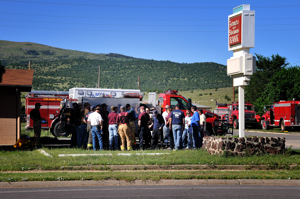
Indeed, the responders were waiting in the parking lot of Farmers and Stockmens Bank, out of sight about a quarter mile from the scene. They knew something big was coming for this training exercise, but they knew no details until the events unfolded.
The patients had arrived at the Des Moines EMS building at 7:30 to be briefed on their injuries and receive moulage – the sophisticated makeup simulating those injuries. At 9 a.m. they listened to instructions and further training from six of the event’s organizers in succession, even as the emergency responders gathered to receive their instructions in the shade of the bank, where morning grogginess was rapidly being replaced by adrenaline.
At 9:30 the patients took their positions in and around four wrecked vehicles which had been spilled into position with a backhoe Friday night by Des Moines EMS Director Paul Briesh. When Folsom EMS Director and Medical Operations Manager Kim Atwater issued the emergency call, the exercise’s dedicated radio channel came to life as, one by one, the various units responded.
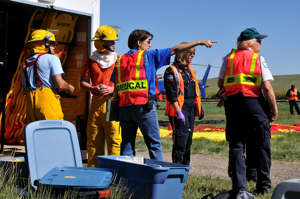
Each of the four surrounding areas – Folsom, Capulin, Grenville, and Des Moines – sent its ambulance and multiple fire trucks. Union County Undersheriff Colleen Johnston started from Clayton. New Mexico State Police sent a unit to control highway traffic as emergency vehicles arrived and departed.
Just as in actual emergencies, the radio calls from volunteer responders were staggered over several minutes. Folsom EMS was first, at 9:43: “Folsom 2349 is 10-8 to the accident at Des Moines, 3 personnel on board.” The Union County MCI trailer was next, followed by Capulin Rescue, Grenville Fire, Des Moines EMS, and the others, 13 responding vehicles altogether.
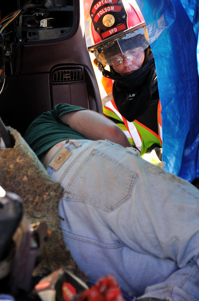
Then, at the accident site, a funny thing happened: absolute stillness and silence. Nothing. As in real life, it takes awhile after the 911 call before those on the scene see anything happen, especially in such a remote area where volunteer responders are dropping everything else – work, dinner, sleep – to don emergency gear and hurry to the EMS or fire building to join their teammates and drive emergency vehicles many miles to the scene.
Saturday’s silence was broken by the distant approach of a helicopter from the north as Flight for Life passed over the Des Moines Cemetery on its way from St. Mary Corwin Hospital in Pueblo to a designated landing zone beside the accident site. Pilot Dale Geanetta shut off the engine, then he and flight nurses John Houston and Lisa Wagner stood by to watch the show: in the planned scenario, they would arrive in a half hour, one of the few timings Saturday that weren’t remarkably realistic.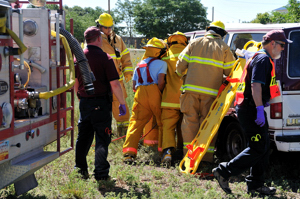
Over the next ten minutes, the silence was replaced by controlled chaos as ambulances and fire trucks discharged 48 EMTs and firefighters, overseen by an Incident Commander, Des Moines Paramedic Jan Pryor, who was assisted by Medical Operations Manager Kim Atwater, Safety Officer David McDonald, Logistics Officer Brad Atwater, Triage Officer Paul Briesh, and Union County Emergency Manager Zina Schamber.
While some EMTs set up equipment and triage stations for the multiple casualty incident, others took inventory of the scene and patients. Is the scene safe? How many vehicles are involved? Is there a vehicle missing, out of sight? What specific damage occurred to each vehicle, and how might that affect each occupant?
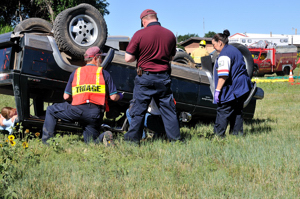
Did an airbag deploy? Was this patient belted? How many people were in this car? Is anyone missing, perhaps thrown into the bar ditch? Which patient should be treated first? What should be done with the others?
One vehicle is balanced precariously on its side and has to be stabilized. Patients are still trapped within vehicles. Dressed in full bunker gear on this bright August morning, firefighters hurry to secure the vehicles and gain access for the EMTs.
The EMTs use a universal triage system to sort patients and their care. Each patient is quickly assessed and a triage tag attached with brief notations. A patient with only minor injuries – “the walking wounded” – is designated Green and walked to a safe zone for later treatment. A patient who is dead or almost certain to die is left in place, tagged Black, so EMTs can render aid where they can do more good.

Patients with high respirations, poor blood flow, and/or impaired mental status are designated Red: they get the first treatment. The remaining patients are designated Yellow and escorted to an area where they can get the next available care.
A danger is tunnel vision: a responder easily gets lost in his or her specific response. Accidents can happen. Responders lose track of the big picture. That’s why, in real MCIs and in this drill, one experienced responder takes the duty of Incident Command. That person stands apart, radio in hand, monitoring and directing all activity associated with the scene. As the scene grows, the IC may be joined by a Medical Operations Manager, a Safety Officer, a Triage Manager – even a Public Information Officer to handle media relations.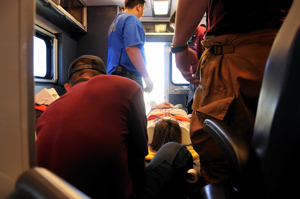
Fortunately, multiple casualty incidents are rare, but that means the responders have little experience with the carefully-orchestrated procedures. They train in classrooms, fire halls, and EMS buildings, but that’s learning by white board, of limited use when the real thing hits the fan. Thus, Saturday’s multi-agency emergency drill.
It was over by 11 a.m., all the patients feeling much better and responders cleaning up the scene. By noon, most of the 60-some participants gathered in the Des Moines EMS building for a de-briefing and lunch.
Colorado Flight Nurse John Houston expressed his helicopter crew’s admiration for the entire morning’s response. He said the drill’s four fire departments and four emergency medical services coordinated their efforts with impressive effectiveness. “It was methodical, step-by-step, and by the book. Most important, it was safe,” he said.
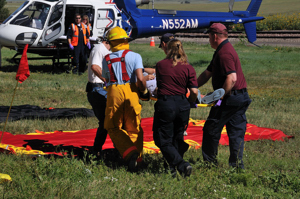
Flight Nurse Lisa Wagner agreed. “It’s easy to see that all these responders are used to working together. They may come from different towns and organizations, but they clearly worked as a single team. I was impressed.”
Although at least two firefighters were briefly treated for dehydration and heat exhaustion after working in their heavy bunker gear under the hot sun, there were smiles and laughter all around as participants recounted the morning’s events over a lunch of barbequed beef. They now had plenty of reason to believe that if – when – the real thing comes along, their team will do just as well as they did Saturday.
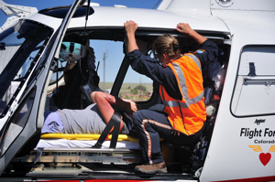
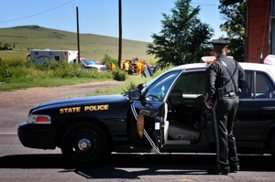
©2010 Tim Keller